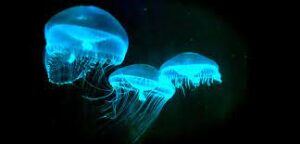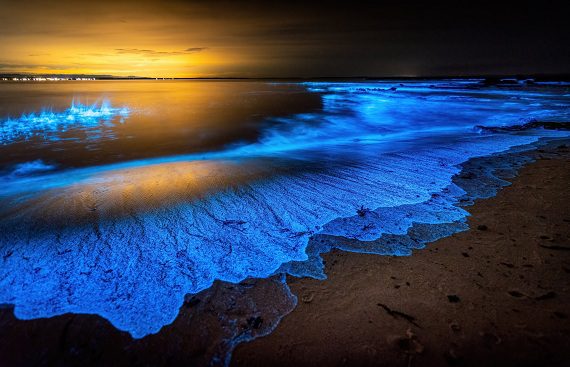The enchanting glow of Deep-Sea Bioluminescence has fascinated scientists and explorers for centuries. From the mysterious depths of the ocean come these bioluminescent organisms, creating a surreal world of light in a pitch-black environment. Let’s embark on a journey to understand this extraordinary phenomenon.
What Causes Bioluminescence?
Bioluminescence, a mesmerizing natural phenomenon, is driven by the remarkable chemistry that occurs within certain organisms. This enchanting display of light is the result of a chemical reaction involving a light-emitting molecule called luciferin and an enzyme called luciferase. In the presence of oxygen, luciferin undergoes oxidation, releasing photons of light. This chemical reaction is finely tuned and highly efficient, making bioluminescence a captivating and energy-efficient means of producing light in the natural world.
Bioluminescence isn’t limited to a single kingdom of life; it can be found in a variety of organisms, from tiny marine plankton to deep-sea creatures and even terrestrial insects. The diversity of bioluminescent species and their ability to generate light through this chemical reaction has long fascinated scientists and continues to be an area of active research.
Adaptations for Survival
Camouflage: Some bioluminescent organisms have evolved to use their ability to emit light for camouflage. In the deep, dark ocean, where sunlight cannot penetrate, many creatures employ bioluminescence to blend in with their surroundings. By emitting light that matches the faint blue glow of the ocean, these animals become nearly invisible to predators and prey alike. This remarkable adaptation allows them to avoid detection and thrive in their unique environment.
Predation: Bioluminescence also plays a pivotal role in the world of predation. Predators, such as the fearsome anglerfish, use specialized bioluminescent lures to attract unsuspecting prey in the pitch-black depths of the ocean. These adaptations highlight the intricate interplay between bioluminescent organisms and their ecological niches, showcasing how light can be a potent weapon in the constant struggle for survival.
Reproduction: For some species, bioluminescence serves as a tool for attracting mates. Fireflies, for example, create captivating light displays to signal their presence and court potential partners. The synchrony of their flashes is a stunning example of how bioluminescence can enhance reproductive success by facilitating communication in the animal kingdom.

Diversity of Bioluminescent Species
The world of bioluminescence is vast and varied, encompassing an astonishing array of species across different ecosystems. From the shimmering bioluminescent algae that light up the ocean’s surface to the flickering fireflies dancing in summer fields, nature has endowed a diverse set of organisms with the ability to create light. In the depths of the ocean, countless species, from the ethereal vampire squid to the elusive dragonfish, utilize bioluminescence for survival, communication, and navigation in the inky abyss.
Ocean Zones
Bioluminescence, the mesmerizing natural phenomenon of living organisms emitting light, can be found in various ocean zones, each offering a unique perspective on this fascinating display. Here are some of the ocean zones where bioluminescence is commonly observed:
Mesopelagic Zone:
The mesopelagic zone, also known as the twilight zone, is located between 200 and 1000 meters (656 to 3280 feet) below the ocean’s surface. This zone is home to numerous bioluminescent creatures, including fish, squid, and jellyfish. These organisms produce light as a means of communication, camouflage, and attracting prey or mates. As sunlight gradually diminishes in this zone, bioluminescence becomes a vital adaptation for survival.
Bathypelagic Zone:
Deeper than the mesopelagic zone lies the bathypelagic zone, extending from 1000 to 4000 meters (3280 to 13,123 feet) beneath the surface. In this zone, bioluminescent organisms continue to thrive, although they have adapted to even greater darkness and extreme pressures. Here, creatures such as the anglerfish employ bioluminescent lures to attract prey in the inky blackness of the deep sea.
Abyssopelagic Zone:
The abyssopelagic zone is the deepest part of the ocean, extending from 4000 meters (13,123 feet) to the ocean floor. While the abyssal plain itself may not host as much bioluminescence due to the absence of large organisms, the surrounding water column still contains bioluminescent species adapted to extreme conditions. These organisms include certain types of plankton and deep-sea creatures that produce light for various purposes, including deterring predators and attracting mates.
Geographic Locations
Apart from ocean zones, bioluminescence can also be found in specific geographic locations around the world. Here are a few notable places where this natural wonder can be witnessed:
The Twilight Zone:
The mesopelagic or twilight zone, as mentioned earlier, is a global phenomenon. It can be observed in various oceans, including the Atlantic, Pacific, Indian, and Arctic Oceans. Key areas to experience bioluminescence in the twilight zone include the Sargasso Sea and the North Atlantic Ocean.
Monterey Bay Canyon:
Located off the coast of California, Monterey Bay Canyon is renowned for its vibrant marine life and bioluminescent displays. Visitors can embark on nighttime boat tours to witness the enchanting spectacle of bioluminescent organisms lighting up the waters of this beautiful bay.
Puerto Rico’s Mosquito Bay:
Mosquito Bay, located on the island of Vieques in Puerto Rico, is famous for being one of the brightest bioluminescent bays in the world. The bay is home to microscopic dinoflagellates, which emit a vivid blue-green glow when disturbed. Kayaking tours at night allow visitors to witness this magical phenomenon up close.
Attracting Prey and Mates
Bioluminescence, the mesmerizing ability of certain organisms to produce light, plays a crucial role in the ecosystem by aiding in the attraction of both prey and mates. Many marine species, such as fireflies, jellyfish, and deep-sea creatures, employ this dazzling display of light to their advantage.
For some species, bioluminescence serves as a hunting strategy. Predators like anglerfish possess a bioluminescent lure that dangles above their mouth, attracting smaller fish with the promise of an easy meal. Once the prey is close enough, the predator strikes, capturing its meal. This mesmerizing light show is a deadly trap for unsuspecting prey.
On the other hand, bioluminescence also aids in the process of finding mates. Fireflies are a well-known example, where males emit rhythmic flashes of light to signal their presence and species identity to potential female partners. These intricate patterns of light serve as a form of communication, helping fireflies find suitable mates amidst the darkness of the night.
Deterring Predators
While bioluminescence is often used to attract prey and mates, it can also serve as a deterrent to predators. Some organisms employ bioluminescent flashes or displays as a defense mechanism, startling or confusing potential attackers.
For instance, the firefly squid, found in the dark depths of the ocean, uses its bioluminescent light to create dazzling, disorienting displays when threatened. This acts as a diversion, allowing the squid to escape from its predators, including larger fish and cephalopods.
Similarly, certain species of jellyfish are equipped with bioluminescent cells in their tentacles. When a predator tries to attack, the jellyfish can release bursts of bioluminescent light, potentially blinding or confusing the attacker long enough for the jellyfish to make a swift getaway.
Scientific Research and Discovery
Bioluminescence also plays a pivotal role in scientific research and discovery. Scientists have harnessed the power of bioluminescent organisms for various purposes, from studying genetic processes to exploring the deepest parts of the ocean.
One area of research that benefits from bioluminescence is molecular biology. Bioluminescent proteins, such as luciferase, are used as markers in genetic studies, enabling scientists to track specific genes and proteins in living organisms. This has revolutionized our understanding of genetics and has applications in medical research, such as cancer studies.
Moreover, bioluminescence has opened the door to exploring the mysterious world of the deep sea. Many deep-sea creatures emit light, and scientists use remotely operated vehicles (ROVs) equipped with bioluminescence-sensitive cameras to capture footage and study these unique ecosystems. Discoveries of new species and insights into the dynamics of these ecosystems have been made possible through the study of bioluminescence.
Bioluminescent Wonders: Exploring the Enchanting Glow of the Deep Sea
Submersibles and ROVs in Bioluminescence Exploration
Submersibles and remotely operated vehicles (ROVs) have revolutionized our understanding of bioluminescence in the depths of our oceans. These advanced technologies enable scientists and researchers to explore the mysterious world of bioluminescent organisms in ways that were once thought impossible.
Submersibles are specially designed submarines that can carry humans to great depths below the ocean’s surface. These vessels provide a unique opportunity for scientists to study bioluminescent creatures in their natural habitat. Equipped with powerful lights and cameras, submersibles can capture stunning footage of bioluminescent displays by various marine organisms, such as jellyfish, squid, and deep-sea fish. These observations not only reveal the beauty of bioluminescence but also shed light on the ecological roles and behaviors of these creatures.
ROVs, on the other hand, are remotely operated robotic vehicles that can reach extreme depths where human divers cannot go. These machines are equipped with advanced imaging technology and manipulator arms, allowing scientists to collect samples, monitor bioluminescent organisms, and study their behavior up close. ROVs are invaluable tools for researchers studying deep-sea ecosystems, as they provide a safer and more efficient means of exploring bioluminescent life in the abyss.
Furthermore, submersibles and ROVs play a crucial role in discovering new bioluminescent species and expanding our knowledge of their biochemical mechanisms. By collecting samples and studying them in controlled environments, scientists can uncover the secrets behind the production of bioluminescent light, which has applications in medicine, biotechnology, and environmental monitoring.
Citizen Science and Bioluminescence: Involving the Public in Discovery
Citizen science initiatives have emerged as a powerful way to engage the public in the exploration and study of bioluminescence. These programs empower individuals of all backgrounds to contribute to scientific research, making bioluminescence accessible to a wider audience.
Citizen scientists can participate in bioluminescence research in various ways. They can join organized bioluminescence monitoring projects, such as recording sightings of bioluminescent events in their local environments or during coastal trips. These observations help researchers track the distribution and frequency of bioluminescent organisms, contributing valuable data to ongoing studies.
Additionally, citizen scientists can collect water samples and perform simple experiments to better understand the conditions that trigger bioluminescent displays. This hands-on involvement not only fosters a sense of curiosity and discovery but also aids scientists in gathering data from diverse geographical locations.
Online platforms and smartphone apps have made it easier than ever for people to report bioluminescent sightings and share their findings with the scientific community. This collaborative effort enhances our understanding of bioluminescence, its ecological significance, and the potential impacts of environmental changes on these fascinating organisms.
FAQs
What causes Deep-Sea Bioluminescence?
Deep-Sea Bioluminescence is caused by chemical reactions within specialized light-producing cells, resulting in the emission of light. These reactions involve luciferin, oxygen, and luciferase enzymes.
Why do deep-sea creatures bioluminesce?
Deep-sea creatures use bioluminescence for various purposes, including camouflage, attracting prey, and communicating with mates.
Are there any known dangers associated with bioluminescence?
While Deep-Sea Bioluminescence itself is not dangerous, some bioluminescent organisms can be venomous or pose a threat to other marine life.
Can humans witness Deep-Sea Bioluminescence without specialized equipment?
No, due to the extreme depths at which bioluminescent organisms reside, witnessing Deep-Sea Bioluminescence without specialized submersibles or remotely operated vehicles is nearly impossible.
How is Deep-Sea Bioluminescence studied by scientists?
Scientists use remotely operated vehicles equipped with cameras and sensors to study bioluminescent organisms in their natural habitats.
What role does Deep-Sea Bioluminescence play in marine ecosystems?
Deep-Sea Bioluminescence is essential in marine ecosystems for predator-prey interactions, mate attraction, and overall biodiversity.
Conclusion
Deep-Sea Bioluminescence is a captivating testament to the wonders of our planet. As we venture deeper into the ocean’s abyss, we discover a world where darkness is dispelled by the enchanting glow of marine organisms. This natural spectacle continues to inspire scientific research and ignite our fascination with the mysteries of the deep.
UP NEXT
Exploring the Wonders of Coral Reef Ecosystems
Unveiling the Mystery: The Elusive Giant Squid



